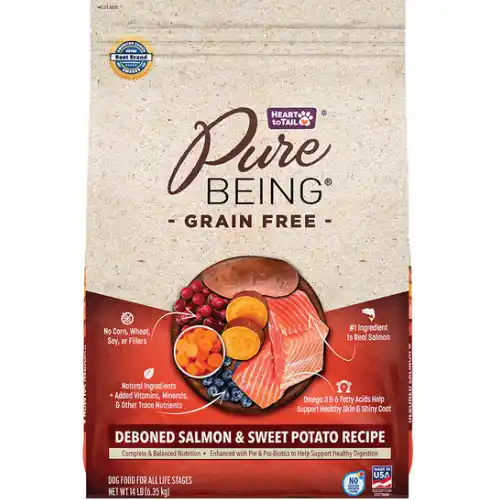It is difficult to analyze dog food from Aldi, as there is little information available to truly determine its quality. Nevertheless, there are a few clues that can help make an educated guess.
- No Corn, Soy, GMO : formulas avoid these common allergens.
- Probiotics
- Natural Preservatives Only
- Competitive Pricing: Significantly more affordable than many mainstream brands
- AAFCO Compliant: Meets AAFCO nutritional standards for dog food
- Named Protein Sources: Clear identification of protein ingredients
- Incomplete Nutritional Information: Ash, calcium, and phosphorus content not provided
- Low Protein Content: The protein level (25%) may not be optimal for very active dogs or those needing higher protein diets.
- High Carbohydrate Content: Due to lower protein levels.
- Limited Omega-3 Content
- Nutrient Representation: Nutrient levels often listed as minimums rather than exact values
- Not Human-Grade: The ingredients used are not certified as human-grade.
- Unclear Professional Involvement: There’s no clear indication of whether a veterinarian or nutritionist is involved in the formulation.
- No Added Taurine: Concerning for a grain-free formula with high levels of plant-based proteins such as peas, which may affect heart health
Aldi Pure Being Dry Food Review Ratings
We will provide a detailed analysis of one recipe, followed by quick reviews of a few other recipes from the brand.
Aldi Pure Being Deboned Salmon And Sweet Potato Recipe


37/100
Ingredients
| Criteria | Evaluation | Comments |
|---|---|---|
| Carbohydrate Levels | 🔴 High (37%) | At this carbohydrate level, the dog’s metabolism will primarily use glucose as an energy source, rather than ketone bodies from fat metabolism. This may be suitable for dogs with fast metabolisms or those needing quick energy, but is less optimal for long-term endurance in working dogs and much less suitable for dogs that are overweight or prone to metabolic diseases. |
| Protein Content | 🔴 Low (25%) | Besides potential muscle loss, proteins play a crucial role in immune function. Such a low level could potentially compromise antibody production and affect overall immune system function. |
| Protein-Calorie Ratio | 🔴 Low (69) | A Protein-Calorie Ratio lower than 80 indicates a very low protein density. This suggests that energy is mainly provided by fats and especially carbohydrates. Except for special cases, this is not ideal. |
| Fat Content | 🟢 Good (15%) | This is a rate found in the average market. The quality of fat sources needs to be verified. |
| Fiber Content | 🟢 Good (3%) | Good fiber level supporting healthy digestion without excess. |
| Moisture Content | 🟢 Good (10%) | Normal moisture level for dry food. Within the norm. This can indicate a fairly respectful cooking process. |
| Calcium Content | ❓ Not specified | Without this crucial information, it is impossible to properly evaluate this kibble. This is essential information for your dog’s bone and overall health. |
| Phosphorus Content | ❓ Not specified | The absence of phosphorus information is concerning. Phosphorus levels are crucial for assessing kidney health, especially in older dogs. |
| Calcium-to-Phosphorus Ratio | 🔴 To Monitor | Impossible to calculate. |
| High Glycemic Ingredients | 🟢 Good | No high glycemic ingredients in prominent positions. |
| Animal vs Plant Protein | 🟠 Average or 🔴 Poor (40-60%) | Plants proteins content seems quite high. It can affect the amino acid profile. |
| Quality of Animal Proteins | 🟠 Average or 🔴 Poor | Minerals content is not provided. Then it’s difficult to evaluate the quality of animal proteins. |
| Type of Preservatives | 🟢 Good | Uses natural preservatives (mixed tocopherols) rather than artificial ones. |
| Manufacturing Location | 🟢 Good | Clear manufacturing location information provided. |
| Cooking Method | ❓ Not specified | No information about the processing methods, which affects nutrient availability. |
| Fat Quality | 🟢 Good | Named fat sources. |
| Omega 6:3 Ratio | ❓ Not specified | Unable to assess fatty acid balance, which is important for inflammation management. |
| Brand Transparency | 🔴 Poor | Some basic information provided, but room for improvement in ingredient sourcing details. |
| Added Taurine | 🔴 To monitor | No added taurine despite being grain-free with high plant protein content, which may affect heart health. |
| Veterinary-Formulated | 🔴 Caution | No veterinary involvement or lack of information on veterinary involvement. |
| Human-Grade Ingredients | 🔴 No | Human-Grade Ingredients has stricter controls and must be manufactured in facilities certified for human food production. It guarantees higher safety and quality standards than regular pet food manufacturing facilities. |
| Scientific Research Backing | 🔴 No | – |
| Contains Corn, Gluten, Wheat | 🟢 No | – |
Our Opinion
When comparing the composition and rates of Aldi kibble, they do not have to be ashamed when facing the average competitors in the market; in fact, they are even better than the majority. The two most problematic points are the absence of added taurine like Nature’s Variety (following the doubts we now have with grain-free formulas) and the lack of information on calcium, phosphorus, and ash rates that would help determine the quality of the animal proteins used.
If you want better options, check our top best dry food for dogs.


